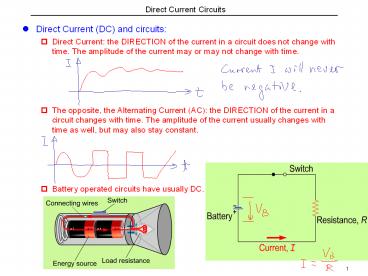Direct Current Circuits - PowerPoint PPT Presentation
1 / 18
Title:
Direct Current Circuits
Description:
Direct Current Circuits Direct Current (DC) and circuits: Direct Current: the DIRECTION of the current in a circuit does not change with time. The amplitude of the ... – PowerPoint PPT presentation
Number of Views:377
Avg rating:3.0/5.0
Title: Direct Current Circuits
1
Direct Current Circuits
- Direct Current (DC) and circuits
- Direct Current the DIRECTION of the current in a
circuit does not change with time. The amplitude
of the current may or may not change with time. - The opposite, the Alternating Current (AC) the
DIRECTION of the current in a circuit changes
with time. The amplitude of the current usually
changes with time as well, but may also stay
constant. - Battery operated circuits have usually DC.
2
Basic components
- Basic components and their symbols
- Wire connects other components in the circuit,
without any resistance. Symbol - Switch when it is closed, a circuit (a loop for
the current) is formed. Symbol - Resistor the component that follows the Ohms
Law . - Symbol
- Capacitor the component that is defined through
. - Symbol
- Battery the device that
- provides the electric potential
- difference in a circuit, that
- converts other type of energy
- into electric. Symbol
- Inductor will be discussed later part of this
semester. - Transistor not in the scope of this course.
or
3
The battery
- The electromotive force (emf, E) of a battery
- The capacitance of a battery
- This is often specified as Amp?hour or a
variation of this unit (like mA?h) - The internal resistance and the terminal voltage
The external force (mechanical or chemical) that
provides the potential difference is called the
electromotive force. For a battery, this emf
comes from chemical reactions.
4
The battery
- The internal resistance and the terminal voltage
The batterys emf is 1.50V and its internal
resistance is 0.0336 ohm. What is the terminal
voltage with a 5 ohm resistor load?
Question how do you measure the emf?
5
The battery
- Maximum efficiency of the battery and the maximum
power the battery can deliver.
The efficiency is defined as
emf, E
R, the load
With a load R, the power delivered to the load is
6
The battery
7
The simplest circuit and the electric potential
in a circuit
- The simplest circuit
- The electric potential in the loop
8
Ammeter, Voltmeter and a DMM
- Ammeter
- Voltmeter
- DMM digital multi-meter (ammeter, voltmeter,
ohmmeter, )
- Ammeters measure current.
- Always connect the ammeter in
- the circuit and the current flows
- through the ammeter.
- The internal resistance of an
- ammeter is very small.
- Voltmeters measure voltage.
- Always connect the voltmeter
- across the component of which
- the voltage over it is to be
- measured.
- The internal resistance of an
- voltmeter is very large.
9
Resistors in a circuit
- One resistor in a circuit ? Ohms Law.
- Two resistors connected in
- Series
- Parallel
10
Resistors in a circuit
- Current, voltage and power division over two
resistors when they are in - Series
- Parallel
11
Resistors in a circuit
- Three resistors connected in
- Series
- Parallel
12
Resistors in a circuit
- Mixed connections
13
More examples
What is the total current I, and the current,
voltage and power over each resistor?
14
More examples
15
The Kirchhoffs Rules
- The Kirchhoffs rules
- The loop rule
- The sum of the changes in electric potential
across all components around any complete loop of
a circuit is zero. - The junction rule
- The total current flowing into a junction
- equals the total current flowing out of
- a junction.
- Steps in solving a problem
16
More examples
17
One more example
What current flows through the 5.00 O resistor?
18
One more example































